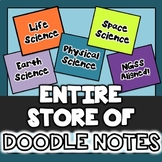Resource Distribution Science Doodle Notes + Interactive NGSS MS-ESS3-1
- PDF
What educators are saying
Also included in
- Doodle notes to help build NGSS vocabulary skills. Use these science notes to parallel your lessons and add visual triggers to improve memory of content. These doodle notes specifically address the NGSS standards for middle school, while providing concrete visuals to support learners of all abilitiPrice $172.45Original Price $215.56Save $43.11
- These MS-ESS3 NGSS doodle notes were created to supplement your existing lessons and activities. Learning happens when students pose questions, plan investigations, develop models, gather and make sense of information, analyze and interpret! BUT... Let’s be REAL folks. Using class time to engagePrice $15.16Original Price $18.95Save $3.79
- ESS Vocabulary SCIENCE Doodle Note Bundle for ALL Middle School Earth and Space Science Key Ideas(Watch the video preview for an overview of what pages are included.)Interactive doodle note glossary for supporting the core ideas listed in the EARTH and SPACE Next Generation Science Standards for midPrice $60.68Original Price $75.85Save $15.17
- This doodle note bundle includes a huge variety of middle school science notes. These doodle notes have been used in my classroom and so many others. They will engage your students and save you hours of time!This product is listed at a 30% discount. Any new doodle note resources added to my TpT stoPrice $323.11Original Price $403.89Save $80.78
Description
Use these resource doodle notes to build science vocabulary to support learning about Earth and Human Activity. These visual notes give a short review of these major topics: Fossil Fuels, Coal, Non-renewable Resources, Petroleum, Ores, Mineral Extraction, Groundwater, Uneven Resource distribution.
Use these doodle notes as bellringers, classwork, homework, or small group discussion prompts. These can be done whole group or independently. Daily exposure to vocabulary improves longterm memory. These doodle tasks introduce or review a wide range of Earth and Human Activity topics while making the information bite-sized and less intimidating.
This Doodle Note Printable includes these activities:
- Posing questions about Oil, Natural Gas and Coal
- Doodling a sequence picture that shows how coal formed over millions of years
- Making inferences about Earth's climate millions of years ago using the location of resources today
- Creating word art to show understanding of renewable vs non-renewable resources
- Writing captions for pictures modeling how Petroleum formed over time
- Listing the world's largest oil reserves
- Interpreting a chart to determine where resources come from to construct a light bulb
- Making inferences about resource distribution and tectonic plate movement
- Doodling ways that humans depend on Earth's atmosphere, biosphere and hydrosphere
- Charting the benefits and drawbacks of mining for resources
- Discussing global consequences of unevenly distributed resources
Climate: ESS 3-1 Earth and Human Activity
5 doodle note pages that address the 9 key vocabulary terms for middle school standard ESS3-1
Includes:
- PDF of Doodle Notes (5 doodle note pages- see preview for pictures)
- Fully Colored and completed ANSWER KEYS
- BONUS Interactive Tool for Students! A link will be included with your pdf download. Share the provided link with your students and they can click through the Doodle Note Interactive Pages to gather content for each section. They will watch videos and read text that will give them the information needed for each doodle task. This is ideal for self-directed learning!
MS-ESS3-1
Vocabulary included: Fossil Fuels, Coal, Oil, Natural Gas, Petroleum Formation, Non-renewable, Ore, Geological Process, Mineral Extraction, Groundwater Resources, Resource Distribution
NOTE: This is part of a larger set of Earth Science Vocabulary Doodle Notes and is intended to be used as a set!
Doodle notes...
- help students record learning and make meaning of new knowledge.
- chunk information into digestible bites and age-appropriate scaffolding.
- help students associate images with concepts which triggers their memory for knowledge application.
NOTE: These are for students in grades 6-8, as they specifically align to the Next Generation Science Standards for that age range. This is part of a larger set of SCIENCE doodle notes for middle school. It is recommended that they be used together and with this age group specifically.
If you have any questions, I'd love to hear from you!
Kate @ Captivate Science









